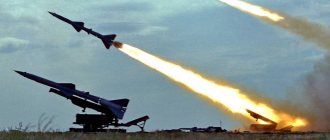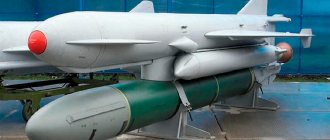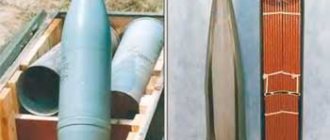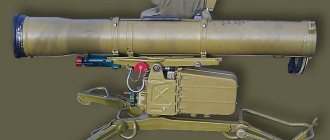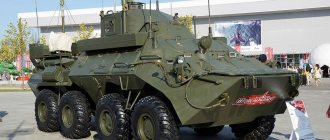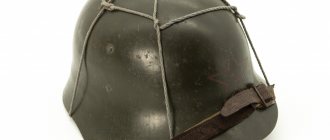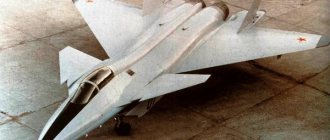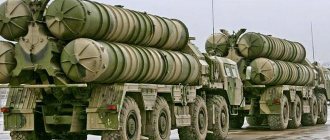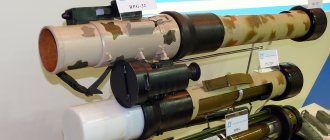The last salvos of the Second World War died down. The victorious countries, and other states as well, continued to build up and restore the military potential of their armies. Tank units played the main role on the battlefield. In spite of the development of tanks, countermeasures were also improved.
Anti-tank artillery guns, due to their short life on the battlefield, increased maneuverability of targets, and the appearance of other armored participants in battles, did not provide the infantry with full-fledged defense against iron monsters. The developers of guided anti-tank weapons, including the Fagot ATGM, found a way out.
Story
One of the first complexes adopted by the Soviet Army was the famous “Malyutka” (ATGM 9K11, developed in 1960). But soon motorized rifle units needed more modern weapons that would not require lengthy training of personnel and had high technical characteristics.
In the spring of 1963, by decision of the Commission on Military-Industrial Issues under the Council of Ministers of the USSR, the Instrument Design Bureau, located in the city of Tula, was instructed to begin developing a second-generation anti-tank missile system, with warhead control by wire.
The targets for the product had to be visually observable:
- armored objects stationary or moving at a speed of less than 60 km/h;
- enemy fire weapons hidden and protected by shelters.
The range to ensure effective destruction should be no more than 2 km. By 1967, the first sample was ready, the tests of which failed miserably.
After a number of improvements and corrections, a new stage of inspections began at the beginning of 1969, but it also ended poorly. The complex was considered not ready for mass production.
Design bureau employees quickly eliminated the comments received and after successfully passing the exams in the early fall of 1970, the 9K111 “Fagot” ATGM with the 9M111 missile was adopted by the Soviet Army.
By the end of 1971, serial production was established at Kirovsky.
By 1975, the warhead of the complex was modified, including the introduction of new missile models:
- 9M111-2 with increased armor penetration;
- 9M111M "Factoria" with increased flight range;
- later the 9M113 Konkurs missile was added.
The 9M113 missile, created in the mid-seventies, had improved armor penetration and lighter weight. The warhead is built according to the tandem type and was originally created as a separate anti-tank weapon.
The ammunition of the portable Fagot and the self-propelled Konkurs are interchangeable.
Modifications
With a 120 mm 9M111 "Fagot" rocket With a 135 mm 9M113 "Konkurs" rocket
Rockets
- 9M111 Bassoon (NATO: AT-4 Spigot and AT-4A Spigot A) - in service since 1970. Rocket caliber 120 mm.
- 9M111-2 Bassoon (NATO: AT-4B Spigot B) - a missile with a modernized remote control. Rocket caliber 120 mm. The maximum firing range is 2000 m. The armor penetration of warheads is up to 460 mm of homogeneous armor.
- 9M111M Factoria / Fagot-M (NATO: AT-4C Spigot C) - the design of the hull and warhead funnel has been changed to accommodate a charge of increased mass and armor penetration. The maximum firing range is 2500 m.
- 9M113 Competition - rocket caliber 135 mm. The maximum firing range is 75–3000 m. The armor penetration of the cumulative warhead is up to 600 mm.
- 9M113M Competition - rocket caliber 135 mm. Firing range - 75-4000 m. Armor penetration of a tandem-cumulative warhead - up to 800 mm behind the remote zone.
Starting devices
- 9P135 - launcher weight 22.5 kg. Can only be used with 9M111 Fagot series missiles.
- 9P135M - can be used for firing and guiding both 9M111 Fagot and 9M113 Konkurs missiles.
- 9P135M1 - modernized version of 9P135.
- 9P135M2 - modernized version of 9P135.
- 9P135M3 - entered service in the early 1990s. It has a 13 kg thermal imager with a guidance range of up to 2500 m (at night).
- 9S451M2 is a developed launcher with a night sight equipped with an automatic dimming system.
Launcher
The launch of anti-tank rockets is carried out using a launcher consisting of:
- control unit 9С451;
- sight 9Sh119;
- launch mechanism 9P155;
- machine 9P56.
The ground control unit is designed to search and detect a target, monitor it, fire a shot, and accompany a rocket to an object.
The infrared sight allows the gunner-operator to observe the aiming point and keep the missile on the aiming line. It is also equipped with a light interference indicator, through which the gunner is informed that there is interference in the field of view that affects the guidance process.
The trigger mechanism has a mechanical safety and a trigger guard, which is pressed to fire a shot.
The machine is a tripod with a swivel, lifting and rotating mechanism, allowing for all-round firing. It is designed in such a way that the shooter has to take a lying position or fire from a trench.
But this reduces the combat profile and increases the survivability of the weapon on the battlefield, which plays a major role in defensive operations and fire ambushes. The 9P135M launcher modification can be installed on military equipment, including BMP-2 and BMD-2.
If necessary, two crew members can easily transfer the complex from a machine version to a portable one.
Video about ATGM "Fagot"
The last salvos of the Second World War died down. The victorious countries, and other states as well, continued to build up and restore the military potential of their armies. Tank units played the main role on the battlefield. In spite of the development of tanks, countermeasures were also improved.
Anti-tank artillery guns, due to their short life on the battlefield, increased maneuverability of targets, and the appearance of other armored participants in battles, did not provide the infantry with full-fledged defense against iron monsters. The developers of guided anti-tank weapons, including the Fagot ATGM, found a way out.
Missile in transport and launch container
The container is a fiberglass tube with removable lids.
The rocket consists of four parts:
- manager;
- combat;
- motor;
- auxiliary.
The control part is created according to a special aerodynamic “canard” design and is responsible for aiming the shot at the target. Plastic rudders equipped with an electromagnetic drive are mounted in the nose of the rocket itself.
The tail section is equipped with a tail unit in the form of petals that open after firing. They are made of flexible steel, laid inside the TPC and open under the influence of the elastic force of the material after leaving the container.
Control is carried out by rudders located in the head of the rocket, and the signal is delivered from ground control equipment via wires. The tail unit prevents the rocket from yawing and leaving its flight path.
The warhead consists of a shaped charge that allows you to disable enemy equipment or a hidden firing point. Allows penetration of up to 400 mm of homogeneous armor. The tandem warhead allows it to penetrate up to 460 mm of armor.
The propulsion part is equipped with a twin-nozzle jet engine and a powder expelling charge. The expelling charge was intended to launch the missile from the TPK to the firing line.
The main engine began working after reaching the target line and delivered the warhead to the target.
The auxiliary part is located in the tail unit and consists of an inertial coil with a field cable and a headlight with a mirror. The field cable is designed to communicate commands to the electromagnetic rudders from the launcher. When fired, these elements are protected by a curtain from the effects of the powder expelling charge, which brings the rocket to the aiming line.
The combustion elements of this charge simultaneously warm up the mirror so that it does not sweat at negative air temperatures during flight. The lamp is coated with a special varnish that protects the gunner's eyes from glare when fired.
The first modifications used a tracer, but it had to be abandoned because sometimes the control wire was burned out. The projectile became uncontrollable and did not obey the shooter’s commands.
The headlight is facing the gunner and is designed for precise guidance of the missile and visual observation of it. After the rocket entered the flight path, the lamp was turned on. The gunner watched her and the target at the same time through the sight. With the help of a lifting and turning mechanism, he aligned the mark with the target and accompanied the object.
The infrared direction finder recorded the position of the missile using the headlight lamp, issued commands to the rudders and put it on a course of approach to the target until the moment of impact.
Stabilization during flight is carried out due to rotation around its axis. The complex can be equipped with a “Mulat” thermal imaging sight. Ensuring reliable detection of enemy equipment at ranges up to 3600 m.
Description
Each complex consists of a launcher with control equipment, a launch mechanism and a 9M111 missile (or its modification) in a fiberglass container. The launch container is disposable.
The 9P56M launcher can also be used to launch the Konkurs and Konkurs-M ATGMs. The machine consists of a swivel and a tripod, as well as a rotating and lifting mechanism. The complex includes a 9P155 trigger mechanism. The 9S451 control device receives a signal from the lamp reflected in a special mirror and determines the position of the rocket in space.
The complex's equipment allows you to detect and track a target, launch an ATGM, determine the location of the missile along the entire flight path and control its movement.
The missile launch container is a fiberglass tube with removable front and back covers.
The 9M111 missile is made on a canard aerodynamic design; it has a length of 900 mm and a caliber of 120 mm. The control surfaces are located at the front of the rocket. The ATGM consists of four parts:
- electromagnetic steering wheel drive;
- warhead (warhead);
- propulsion system;
- compartment for control equipment.
At the rear of the rocket there are load-bearing surfaces that open after launch. They are made of thin steel sheets that are twisted around the rocket body before being installed in the container. After launch, they open on their own.
The ATGM is equipped with a single-chamber jet engine with two nozzles, as well as an expelling charge, which removes the missile from the container and sets its initial speed. The equipment compartment contains a control unit, an inertia-free coil with a wire 2000 or 2500 meters long, a coordinator and a headlight lamp. The headlight lamp is equipped with a special filter that converts most of the light into infrared radiation. The headlight lamp and reflector are protected from the action of the expelling charge by special curtains, which open after the rocket's propulsion engines are turned on.
During flight, the rocket is stabilized by rotation. The change in position in space occurs due to the rotating bow rudders. The control equipment includes a gyroscope, which is spun by a powder charge.
The complex is equipped with a manual start mechanism and a fuse. The Fagot sight has a range of four thousand meters; this ATGM can be equipped with a Mulat thermal imaging sight, capable of detecting tanks at a distance of 3600 meters.
The Fagot ATGM is easy to operate, it is easily transported and installed by a crew of two people. The crew commander carries the folded launch complex, its weight is 22.5 kg, and the second number carries a bale with two missiles in launch containers. The weight of such a bale is 26.85 kg.
The deployment time of the complex is 2.5 minutes.
Performance characteristics
Thanks to its technical characteristics, the Fagot can confidently destroy tanks and armored vehicles of any army in the world.
Performance characteristics of a portable ATGM
| Characteristic | 9M111 | 9M111M | 9M113 |
| firing range, m | from 70 to 2000 | from 75 to 2500 | from 75 to 4000 |
| caliber, mm | 120 | 120 | 120 |
| rate of fire, shot/min. | 3 | 3 | 3 |
| flight speed max, m/s | 240 | 240 | 250 |
| flight time max, s | 11 | 13,5 | 12 |
| armor penetration, mm | up to 400 | up to 460 | up to 600 |
| armor penetration at an angle of 60°, mm | up to 200 | up to 230 | up to 250 |
| weight in stowed position, kg | 49,4 | 47,1 | 47,7 |
| pack No. 1 (launcher), kg | 22,5 | 22,5 | 22,5 |
| pack No. 2 (two missiles in containers), kg | 26,9 | 24,6 | 25,2 |
| weight in combat position with container, kg | 36 | 34 | 34 |
| calculation, pers. | 2 | 2 | 2 |
| time of transfer to combat position, s | 150 | 150 | 150 |
Ease of operation, small dimensions, weight allowing maneuvering across the battlefield, high accuracy and efficiency allow the use of this type of weapon in almost any combat operation.
With success, the Fagot ATGM can be used against well-protected and hidden weapons, command and observation posts, artillery fire spotters and snipers, as well as low-speed low-flying objects.
The only drawback is that you can hit targets that are in visual contact with the gunner-operator.
A fifty-year-old veteran of combat operations and service in various armies of the world, he is still in demand today.
It is used in a number of civil wars and conflicts around the globe. In the news from hot spots, various combat units that have fallen victim to the Fagots appear every now and then.
Device
The Konkurs ATGM consists of three components of equal importance. First of all, this is a combat vehicle, on the turret of which the “Competition” was located.
In it, the turret compartment was completely re-equipped and adapted for an anti-tank complex.
The second component of the “Competition” is the 9P135 launcher. It consists of stationary fasteners, brackets, five containers and radio-electric components, which are connected to a control panel located inside, at the gunner’s position.
The third component of the “Competition” is the 9M113 rocket. It is placed in containers on the launcher. The launch occurs only after a command is given by the operator of the implement.
You can fire at enemy armored targets not only from the BM 9P148, but also from the machine gun. The Konkurs ATGM can be equipped with motorized rifle units that have a shortage of military equipment when conducting defensive operations. In this case, the “Konkurs” is installed on the BMP-2, or the missile is fired by an operator from a tripod mounted on the ground.
Bottom line
Time passes, technology is modernized. The world's leading armies are adopting or are already in service with technical countermeasures against anti-tank systems.
The use of optical-electronic signal suppression leads to a decrease in the efficiency of the control circuit on second-generation missiles. But they are being replaced by new models of weapons, with a control system more protected from various types of interference and the most powerful tandem-type shaped charges.
This allows you to confidently and reliably hit targets with dynamic protection and upgraded armor.
Sources
- Karpenko A.V. Russian missile weapons 1943-1993. – St. Petersburg: “Pika”, 1993.
- ATGMs of the ground forces. Series “Archive 500+” - K.: “Archive-Press”, 1997.
- Angelsky R.D. Domestic anti-tank systems - M: Astrel Publishing House LLC, 2002. - 192 p.
- Military parade
- FAS – www.fas.org
- Russian Missile Systems – www.wonderland.org.nz
- Bharat-Rakshak – www.bharat-rakshak.com
The 9K111 “Fagot” portable anti-tank system is designed to destroy tanks and other armored targets, as well as helicopters and enemy firing points.
The development of the Fagot ATGM began in March 1963 at the Instrument Design Bureau (Tula). Full-scale development of work on “Fagot” was started by decision of the Commission on Military-Industrial Issues under the USSR Council of Ministers dated May 18, 1966, No. 119.
Factory tests of the complex, carried out in 1967-1968, were unsuccessful. The last stage of factory testing began in January 1969, but due to the low reliability of the wired communication line, the tests were stopped again. After troubleshooting, they were completed in April-May 1969. And in March 1970, joint (state) tests of the complex were completed. By Decree of the Council of Ministers No. 793-259 of September 22, 1970, the “Fagot” complex was adopted for service. In 1970, an installation batch of “Bassoons” (100 pieces) was ordered from the Kirov Mayak plant, and the following year their serial production began there. The production of Fagots at the Mayak plant was established in the fourth quarter of 1971, when 710 shells were delivered. In 1975, a modernized version of the 9M111M missile was created with an increased flight range and increased armor penetration. The modernized model of the complex was called 9M111M “Factoria”.
The 9K111 “Fagot” complex was exported to many countries around the world and was used in many local conflicts in recent decades. In addition to Russia, a complex of various modifications is in service with the ground forces of Afghanistan, Bulgaria, Hungary, India, Jordan, Iran, North Korea, Kuwait, Libya, Nicaragua, Peru, Poland, Romania, Syria, Vietnam, Finland.
Video
The Fagot anti-tank missile system is a second-generation anti-tank missile system; it is the first domestic example of such a weapon with a semi-automatic control system. The development of this complex began back in the 60s of the last century, it is still in service with the Russian army, and is used in dozens of other armies around the world.
Capabilities
Koroviev-Fagot, like Woland, knows how to read minds and manipulate mentality and matter. In addition, Koroviev-Fagot has the ability to teleport or pass through walls - he entered the sealed room of the deceased Berlioz, leaving the seal unharmed. Bassoon, like other members of Woland's retinue, is capable of unexpectedly appearing and disappearing. It is interesting that Fagot can teleport not only himself, but also the enemy - together with other members of Woland’s retinue, in an instant he moved Likhodeev from Moscow to Yalta, the distance between them is more than 1500 km!
In terms of matter manipulation, Fagot is capable of creating things out of nothing. For example, during a performance at the Variety Theater, Koroviev blew and a chair appeared on the stage. Before this, Rimsky’s watch appeared in his hands, which he kept under his jacket, and which disappeared from there. A little later, at the behest of Koroviev, a whole women’s store with dresses, hats and other things appeared on the stage of the theater. He is also able to expand the room to the desired limits, connecting this with the fifth dimension.
Regarding mental manipulation and extrasensory perception, Fagot can effortlessly determine an opponent's weaknesses and what the opponent was doing the day before. So, during a performance at Variety, Koroviev publicly convicted the man he saw for the first time of cheating on his wife. The next day, Fagot came to the city entertainment branch and, using black magic, forced the employees of the institution to sing in chorus against their will (they tried to close their mouths and not sing anymore, but he did not listen to them).
Koroviev as a knight.
Gellas
On Vorobyovy Gory, Fagot demonstrated another of his abilities - whistling:
| “ | He suddenly stretched upward, as if he were rubber, made some kind of cunning figure from the fingers of his right hand, curled like a screw, and then, suddenly unwinding, whistled. Margarita did not hear this whistle, but she saw it at the same time as her together with the hot horse it threw ten fathoms to the side. An oak tree next to her was uprooted, and the ground was covered with cracks all the way to the river. A huge layer of shore, along with a pier and a restaurant, was thrown into the river. The water in it boiled, rushed up, and a whole river tram with completely unharmed passengers splashed onto the opposite bank, green and low-lying. A jackdaw, killed by Fagot's whistle, was thrown at the feet of Margarita's snoring horse. | ” |
Notes
- Afranio // Encyclopedic Dictionary of Brockhaus and Efron: in 86 volumes (82 volumes and 4 additional). - St. Petersburg, 1890-1907.
- ↑ Terekhin R.P., Apatsky V.N.
Methods of teaching playing the bassoon. - M.: Muzyka, 1989. - ↑ Mailyan G.
Bassoon in Armenia. - Yerevan: Author's Publishing House, 2009. - K. Wagner
. Die Fagott-Instrumente des 17. Jahrhunderts (dissertation, University of Basel, 1976) - W. Montgomery
. The Life and Works of François Devienne, 1759–1803 (dissertation, Catholic University of America, 1975) - Berlioz G.
Large treatise on modern instrumentation and orchestration. (In 2 parts). Translation, editing, introductory article and comments by Gorchakov S.P. - Music, 1972. - P. 241.
Design and principle of operation[edit]
The ATGM is triggered in the following steps:
- The operator visually points the complex at the target using an optical sight. The ATGM itself cannot detect and track targets, so it is considered semi-automatic.
- The operator gives the command to launch the ATGM and the ejector motor fires.
- The 9M111 missile, having left the ATGM, straightens the rudders made of thin stainless steel, which simply, due to their elasticity, collapse when inserted into the ATGM.
- Behind the rocket, the control wire begins to unwind from the coil.
- After the ATGM has left the ATGM, a protective curtain with a lamp in the rear of the missile opens.
The 9Sh119M1 optical receiver on the ATGM detects the angular coordinates of the ATGM based on the operation of the lamp and begins to issue commands over the wire to keep the ATGM on the aiming line. The 9Sh119M1 receiver can also inform the operator if the target is trying to interfere with light during the flight of an ATGM.
- The missile sends commands received from the ATGM to the rudders using electromagnetic drives. Moreover, when issuing commands, the rocket also uses data from the gyroscope built into it to take into account its current angular orientation in space. The rocket's flight path is a spiral.
- Since the ATGM does not see the target itself, but only follows the operator’s sight, the operator himself needs to keep the target in sight if it moves, which requires special training.
Compound
Combat vehicle 9P148
Main article
9P148 “Competition” Launcher 9P148
Launcher body 9P148
The Konkurs ATGM is modified in relation to the basic
BRDM-2
.
The changes ensure the placement of the launcher, sighting device, as well as electric drives for their guidance and synchronization. A cutout was made in the original body roof sheet for the exit of the launch guides. The cutout is covered by a rectangular electrically operated hatch. The commander's hatch contains a 9Sh119
with the ability to quickly move roughly manually along the horizon, or smoothly track the target using an electric drive. The sight in the stowed position is closed by an armored shutter with a manual drive. In order to protect the optics, there is a “combat glass” that is opened only during combat work, also manually. A light filter is provided to protect the gunner's vision from the effects of light radiation from a nuclear explosion, laser radiation, etc. The filter drive is also manual.
Launcher 9P135
Starting guides on the roof of the 9P148 housing
Hardware part of the 9P148
made on the basis of portable installation units
9P135
placed in the housing.
Also included in the kit is a 9P56
from the portable version. Thus, it is possible to fully use the anti-tank system outside the combat vehicle, for which it is necessary to dismantle the sighting device, control equipment, remove the machine from the stack and assemble the launcher. No special tools are required for this - all blocks are secured with wing nuts, the sight is removed upward through a special hatch in its turret using a standard turret key.
In addition to standard installation blocks 9P135
, the BM “Competition” contains special blocks:
- light interference indication unit (allows you to detect light interference that interferes with the semi-automatic guidance of the missile at the target);
- built-in equipment for monitoring and testing starting circuits;
- electromechanical guidance and synchronization drives.
The ability to test start-up circuits allows you to check the performance of the entire start-up procedure chain without actually starting up the products. Since the recoilless principle is used to launch a rocket, the launch is accompanied by the emission of a flame torch from the end of the container at approximately 10-15 m. In this regard, reliable insulation of the engine and combat compartments from the effects of flame is extremely important. Checking the start-up circuits allows you to diagnose malfunctions of the air intake protective shutter reset mechanism, breaks in the lines of the limit switches of the “travelling” locking mechanisms and the signaling for closing crew hatches and weapons.
ATGM 9M113
ATGMs 9M14P1, 9M113M and 9M113 in the Tula State Museum of Weapons
Missiles of the 9M113
, 9M111 (and their modifications) are widely described in the literature. The startup process deserves a separate description. Complicated at first glance, it ensures the product is launched only after all the procedures necessary for a reliable start have been fully worked out, and excludes the product from being launched in the event of any malfunctions.
- When the operator presses the “start” button, the electrical circuit of the squib of the hinged front cover of the TPK is closed, the cover opens, releasing the push rod of the squib contact of the power supply compartment (it also contains the Ш9 connector, which ensures switching of the electrical circuits of the rocket and the combat vehicle).
- Under the influence of the squib pulse, the separated batteries close and supply power to the on-board network of the product. The gyro powder generator ignites. After spinning up the gyroscope to operating speed (about 10,000 rpm), the inertial contactor switches the fuse of the expelling charge.
- The expelling charge ignites, pushing the product out of the TPK.
- The main engine is ignited by its own inertial contactor after the missile reaches a speed of about 300 m/s (which occurs at a distance of approximately 70 m from the firing position).
Notes
- Afranio // Encyclopedic Dictionary of Brockhaus and Efron: in 86 volumes (82 volumes and 4 additional). - St. Petersburg, 1890-1907.
- ↑ Terekhin R.P., Apatsky V.N.
Methods of teaching playing the bassoon. - M.: Muzyka, 1989. - ↑ Mailyan G.
Bassoon in Armenia. - Yerevan: Author's Publishing House, 2009. - K. Wagner
. Die Fagott-Instrumente des 17. Jahrhunderts (dissertation, University of Basel, 1976) - W. Montgomery
. The Life and Works of François Devienne, 1759–1803 (dissertation, Catholic University of America, 1975) - Berlioz G.
Large treatise on modern instrumentation and orchestration. (In 2 parts). Translation, editing, introductory article and comments by Gorchakov S.P. - Music, 1972. - P. 241.
Bassoon (ptrk)
Operators
Operators of the Konkurs ATGM
- Azerbaijan - 20 9P148 combat vehicles and 400 9M113 missiles
- Algeria - a number of 9K111-1 "Competition" complexes, as of 2010,
- Armenia - 9 9P148 combat vehicles, as of 2016
- Belarus - a number of 9K111-1 “Konkurs” complexes, as of 2010
- Bulgaria - 236 complexes 9K111 "Fagot" and 9K111-1 "Konkurs", as of 2010, 400 ATGM 9M113 were produced under license for the period from to 1996
- Hungary - 100 combat vehicles and 2060 9M113 missiles were supplied from the USSR between 1988 and 100 9K111-1 Konkurs complexes are still in service as of 2010
- Guinea - a number of 9M113 ATGMs, as of 2010
- Georgia - some 9M113, as of 2017
- GDR - 52 9P148 combat vehicles were supplied from the USSR in the period from to 1983, 11,200 9M113 missiles were supplied from the USSR in the period from to 1989
- Egypt - 580 9M113 missiles for Fahd armored personnel carriers were supplied from Russia between 1995 and 1995
- India - 110 SPTRK based on BRDM-2 with 9M111 and 9M113 missiles (presumably 9P148), as of 2010, 1000 9M113 missiles were supplied from the USSR between 1991 and 1991. 25,000 9M113 missiles ordered from the USSR in 1988, produced under license since 1992 (including the 9M113M version), as of 2011, 12,800 missiles were produced
- Iraq - served with the Iraqi Army during the Gulf War
- Iran - a number of 9K111-1 “Konkurs” complexes, as of 2010, missiles are produced under license under the designation Towsan-1, between 2011 and 2400 9M113 units were produced
- Kazakhstan - a number of 9K111-1 “Konkurs” complexes, as of 2010
- Kyrgyzstan - 12 units 9K111-1 “Competition”, as of 2016
- DPRK - a number of 9K111-1 “Konkurs” complexes, as of 2010
- Cote d'Ivoire - a number of 9K111-1 "Competition" complexes, as of 2010
- Libya - a number of 9K111-1 “Konkurs” complexes, as of 2010
- Moldova - 19 9K111-1 “Competition” complexes, as of 2010
- Morocco - 100 9M113 missiles delivered from Russia in 2001
- Poland - 800 9M113 missiles were supplied from the USSR between 1989 and 1989; as of 2010, 18 9K111-1 Konkurs complexes are still in service
- Russia: Ground Forces of the Russian Federation - a number of 9K111-1 “Konkurs” complexes, as of 2010
- Coastal forces of the Russian Navy - 72 complexes 9K11 "Malyutka" and 9K111-1 "Konkurs", as of 2010
Operating principle
Thanks to the infrared lamp, which illuminates the target while aiming, the launcher (via electronics) receives a command that adjusts the missile and launches at the most advantageous moment. All that is required of the gunner operator at this stage is to keep the target on sight.
After the operator presses the “Start” button, the electronics and squibs are sequentially triggered, after 0.2 seconds the container lid opens and the 9M113 missile rushes towards the target.
There are two flight control modes for the 9M113 missile. In “Semi-automatic mode” the target is illuminated due to the automatic launcher. But this is not the most reliable option, which is why the vast majority of operators use “Manual Mode”.
In this case, the complex gunner himself controls the process of adjusting the 9M113 flight using optical sights and special control knobs.
This complex was nicknamed the “thunderstorm of tanks.” A hit by a 15 kg missile often leads not only to the transfer to the status of “not combat-ready unit” of equipment that recently posed a threat, but also to its complete destruction. But not only enemy tanks should be afraid of the “Competition”.
And on the water, enemy boats and even small ships will not reach their target. The Konkurs ATGM is a striking example of a powerful Russian anti-tank weapon, and this complex is still feared by all tankers in the world.
Notes
- Afranio // Encyclopedic Dictionary of Brockhaus and Efron: in 86 volumes (82 volumes and 4 additional). - St. Petersburg, 1890-1907.
- ↑ Terekhin R.P., Apatsky V.N.
Methods of teaching playing the bassoon. - M.: Muzyka, 1989. - ↑ Mailyan G.
Bassoon in Armenia. - Yerevan: Author's Publishing House, 2009. - K. Wagner
. Die Fagott-Instrumente des 17. Jahrhunderts (dissertation, University of Basel, 1976) - W. Montgomery
. The Life and Works of François Devienne, 1759–1803 (dissertation, Catholic University of America, 1975) - Berlioz G.
Large treatise on modern instrumentation and orchestration. (In 2 parts). Translation, editing, introductory article and comments by Gorchakov S.P. - Music, 1972. - P. 241.
Comments
- anti-tank guided missile
is often encountered , which, however, is not identical to an anti-tank guided missile, since it is only one of its varieties, namely a barrel-launched ATGM. - Which, in turn, was acquired by BMW in June 1939 from Siemens.
- Harald Wolf headed the missile development division at the initial stage after it became part of BMW, and was soon replaced by Count Helmut von Zborowski, who headed the missile development division at BMW until the very end of the war, and after the war he moved to France and participated in the French missile program , collaborated with the engine-building company SNECMA and the rocket-building division of Nord Aviation.
- K. E. Tsiolkovsky himself divided his theoretical developments into “space rockets” for launching a payload into outer space and “earth rockets” as an ultra-high-speed modern vehicle of rail rolling stock. At the same time, he did not intend to use either of them as weapons of destruction.
- Occasionally, the word “missile” could be used in the specialized military press in relation to foreign developments in this area, usually as a translation term, as well as in a historical context. The first edition of the TSB (1941) contains the following definition of a rocket: “At present, rockets are used in military affairs as a means of signaling.”
- See, in particular, the memoirs of V.I. Chuikov, at that time commander of the 8th Guards Army, about the Belgorod-Kharkov strategic offensive operation (fragment of the book “The Guardsmen of Stalingrad Go West”): “Here for the first time I saw how the enemy used against our tanks were anti-tank torpedoes, which were launched from the trenches and controlled by wire. When hit by a torpedo, the tank exploded into huge pieces of metal, which scattered 10-20 meters. It was hard for us to watch the destruction of tanks until our artillery delivered a strong fire strike on the enemy’s tanks and trenches.” The Red Army soldiers failed to obtain new types of weapons; in the case described, they were destroyed by massive Soviet artillery fire. The quoted episode appears in several editions of this book.
- It would be interesting to note that by 1965, Nord Aviation had become a world leader in the production and sale of ATGMs on the international arms market and practically a monopolist of their production among the countries of the capitalist world - 80% of the ATGM arsenals of capitalist countries and their satellites were French SS.10, SS missiles .11, SS.12 and ENTAC, of which by that time a total of about 250 thousand units had been produced, and in addition to which at the exhibition of weapons and military equipment during the 26th Paris International Air Show in June 10-21, 1965 The joint Franco-German HOT and Milan were presented.
Notes
- Afranio // Encyclopedic Dictionary of Brockhaus and Efron: in 86 volumes (82 volumes and 4 additional). - St. Petersburg, 1890-1907.
- ↑ Terekhin R.P., Apatsky V.N.
Methods of teaching playing the bassoon. - M.: Muzyka, 1989. - ↑ Mailyan G.
Bassoon in Armenia. - Yerevan: Author's Publishing House, 2009. - K. Wagner
. Die Fagott-Instrumente des 17. Jahrhunderts (dissertation, University of Basel, 1976) - W. Montgomery
. The Life and Works of François Devienne, 1759–1803 (dissertation, Catholic University of America, 1975) - Berlioz G.
Large treatise on modern instrumentation and orchestration. (In 2 parts). Translation, editing, introductory article and comments by Gorchakov S.P. - Music, 1972. - P. 241.
The birth of a new musical instrument
It is unknown who first invented the bassoon, but Italy is considered to be the birthplace of the instrument in the 17th century. Its ancestor is called the ancient bombarda, a bass instrument of the reed family. The bassoon differed from the bombard in design; the tube was divided into several parts, as a result of which the instrument became easier to manufacture and carry. The sound also changed for the better; at first the bassoon was called dulcian, translated as “gentle, sweet.” It was a long, bent tube on which a valve system was located. The first bassoon was equipped with three valves. Later in the 18th century there are five of them. The weight of the instrument was approximately three kilograms. The size of the pipe when unfolded is more than two and a half meters in length. The counterbassoon has even more – about five meters.
Tool improvement
At first, the instrument was used to amplify and duplicate bass voices. Only starting from the 17th century did it begin to play an independent role. At this time, Italian composers Biagio Marini, Dario Castello and others wrote sonatas for him. At the beginning of the 19th century, Jean-Nicole Savarre introduced the musical world to a bassoon with eleven valves. A little later, two masters from France: F. Treber and A. Buffet improved and supplemented this option. Important contributions to the development of the bassoon were made by the German masters Karl Almenröder and Johann Adam Haeckel. It was they who, in 1831 in Biebrich, founded an enterprise for the manufacture of wind instruments. Almenröder created a bassoon with seventeen valves in 1843. This model became the basis for the production of bassoons, which became the leader in the production of these musical instruments. Until this point, bassoons from Austrian and French masters were common. From birth to this day, there are three types of bassoons: quartbassoon, bassoon, counterbassoon. Modern symphony orchestras still continue to use the contrabassoon in their performances.
The place of the bassoon in history
In Germany in the 18th century, the instrument was at the peak of its popularity. The sounds of the bassoon in church choirs emphasized the sound of the voice. In the works of the German composer Reinhard Kaiser, the instrument receives its parts as part of an opera orchestra. The bassoon was used in their work by composers Georg Philipp Telemann and Jan Dismas Zelekan. The instrument received solo parts in the works of F.Y. Haydn and V.A. Mozart, the bassoon repertoire is especially often heard in the Concerto in B major, written by Mozart in 1774. He performs as a soloist in I. Stravinsky’s works “The Firebird”, “The Rite of Spring”, in A. Bizet’s “Carmen”, in P. Tchaikovsky’s Fourth and Sixth Symphonies, in concerts by Antonio Vivaldi, in the scene with Farlaf in M. Glinka in "Ruslan and Lyudmila". Michael Rabinauitz is a jazz musician, one of the few who began to perform bassoon parts in his concerts.
Now the instrument can be heard at concerts of symphony and brass bands. In addition, he can solo or play in an ensemble.

